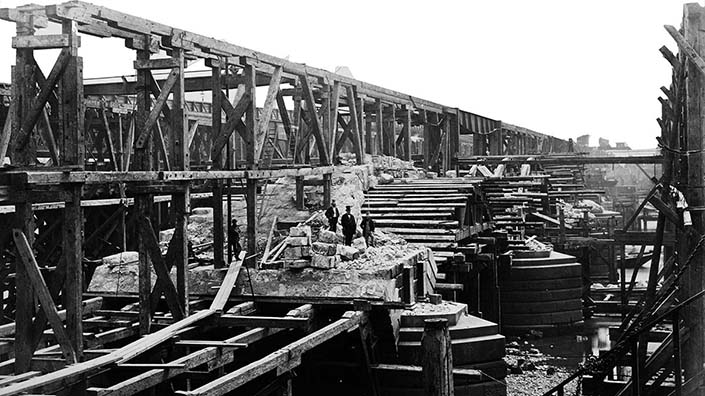Articles
Today, a train journey into London crossing over Blackfriars railway bridge provides the curious sight of a series of bright red bridge columns stretching out across the Thames. A clue to the origin of these columns lies at the south side of the river – a splendidly restored abutment displaying the insignia of the London, Chatham and Dover Railway (LC&DR).
The columns mark the position of the first Blackfriars railway bridge, designed by James Cubitt. Cubitt was also the designer of the Blackfriars road bridge which was being rebuilt at the time the railway bridge was constructed. In 1860 the LC&DR gained permission to build an extension from Kent to Ludgate Hill in the City of London, and work on the bridge started in 1862. Blackfriars station, known until the 1930s as St Paul’s, was opened in 1864.
As the years passed, the railways grew and it was soon necessary to build new lines. A second bridge was built in 1886, designed by W Mills, assisted by John Wolfe Barry and Henry Marc Brunel, the second son of Isambard Kingdom Brunel. Henry Brunel followed in his father’s footsteps as a civil engineer and went on to work on other projects with Wolfe Barry, for example the Creagan Bridge in Argyll.
The two Thames bridges were used to carry trains into St Paul’s station but a century after the first was built it was considered too weak to continue taking a high volume of modern trains. In 1971 all railway services were concentrated on the second bridge, and by 1984 the earlier structure was obsolete and finally dismantled.

Bridge across time
While Cubitt’s railway bridge eventually fell into disuse, his road bridge still stands as a striking example of late Victorian design. Designs to rebuild Blackfriars road bridge were submitted to the Corporation of the City of London in 1860-61, and the foundations were laid in May 1863. The road bridge was completed in 1869 to replace the old bridge which had been in place for 100 years. The foundations of the earlier bridge were giving way, and Cubitt’s wrought-iron rib design was chosen to build a structure that would remain steadfast across the river.
The engineer for the contractor, P & A Thorn, was F W Bryant, an IMechE member and the president of the Society of Engineers. Contemporaries credited Bryant with overcoming many difficulties during the course of the project, in particular working with limited space for construction. The contractor had no room at either of the shore ends of the works for putting up shops or smithies, so instead workers used carpenters’ shops and sawpits standing on large stagings supported by piles.
Photographs in the Archive at the IMechE, available online, show the workers, and the engineers are marked out by their smart dress. In one image, a diver can be seen in Victorian diving gear.
The construction of the bridge took longer than anticipated owing to the difficulty of sinking the iron caissons for the foundations. This process involved both divers and steam engines, which were used to pump out water from the interior of the caissons.
The final cost of the bridge was £400,000, which in 2005 was estimated to be worth £18.28 million. Some 6,000 tons of wrought and cast iron were used in the construction.
* Images of deconstructing the old bridge, preparing for the new and of workers can be seen online at http://archives.imeche.org/archive/industrial/blackfriars-bridge